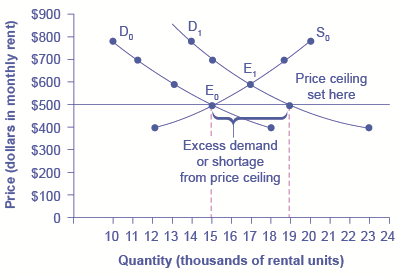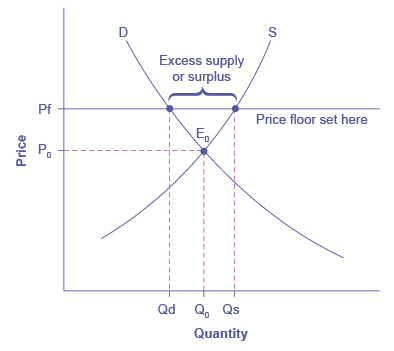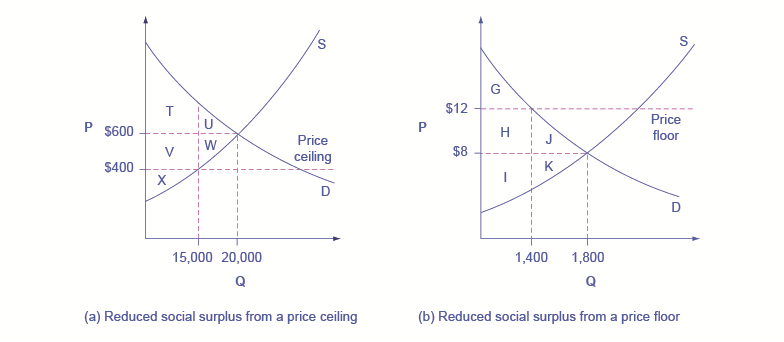2.9 社会目标与市场效率
章节大纲
-
Social Goals vs. Market Efficiency
::社会目标与市场效率Occasionally a government may try to influence prices in the market to achieve a social or economic goal of the country. Price ceilings and price floors occur when the government inserts itself into the marketplace to achieve a specific social situation. Depending on your point of view, you may consider this to be either a necessary situation or the government overstepping its’ boundaries. In either case, prices are a very important aspect of any economic system and impact everyone who enters into the marketplace.
::偶尔,政府可能会试图影响市场价格以实现国家的社会或经济目标。 价格上限和价格底限发生在政府为了实现特定社会状况而投入市场时。 根据你的观点,你可能会认为这是必要的状况,或者政府越了边界。 无论是哪种情况,价格都是任何经济体系的一个非常重要的方面,影响到所有进入市场的人。Price ceilings prevent a price from rising above a certain level. When a price ceiling is set below the equilibrium price, quantity demanded will exceed quantity supplied, and excess demand or shortages will result. Price floors prevent a price from falling below a certain level. When a price floor is set above the equilibrium price, quantity supplied will exceed quantity demanded, and excess supply or surpluses will result. Price floors and price ceilings often lead to unintended consequences.
::价格上限阻止价格高于某一水平。当价格上限设定在平衡价格以下时,所需数量将超过供应的数量,并导致需求过剩或短缺。价格下限防止价格低于某一水平。当设定一个价格下限高于平衡价格时,供应数量将超过要求数量,供应或盈余将超过要求。价格上限和价格上限往往会导致意外后果。Universal Generalizations
::普遍化-
To achieve one or more social goals, the government sometimes sets prices.
::为了实现一项或多项社会目标,政府有时会确定价格。 -
Price ceilings and price floors can distort market outcomes.
::价格上限和价格底限可扭曲市场结果。 -
Price ceilings and price floors prevent equilibrium prices in the market.
::价格上限和价格底价阻碍了市场价格的平衡。
Guiding Questions
::问 问 问 问 问 问 问 问 问 问 问 问 问 问 问 问 问 问 问 问 问 问 问 问 问 问 问 问 问 问 问 问 问 问 问 问 问 问 问 问 问 问 问 问 问 问 问 问 问 问 问 问 问 问 问 问 问 问 问 问 问 问 问 问 问 问 问 问 问 问 问 问 问 问 问 问 问 问 问 问 问 问 问 问 问 问 问 问 问 问 问 问 问 问 问 问 问 问-
Why would the government interfere in the marketplace?
::政府为什么要干涉市场? -
How can the government help to create equity and security in the free market economy?
::政府如何帮助在自由市场经济中创造公平和安全?
Price Ceilings and Price Floors
::物价上限和价格底价Controversy sometimes surrounds the prices and quantities established by demand and supply, especially for products that are considered necessities. In some cases, discontent over prices turns into public pressure on politicians who may then pass legislation to prevent a certain price from climbing “too high” or falling “too low.”
::有时,对供求确定的价格和数量存在争议,特别是对于被视为必需品的产品而言。 在某些情况下,对价格的不满转化为对政客的公开压力,政客可能随后通过立法防止某种价格“过高 ” 或“过低 ” 。The demand and supply model shows how people and firms will react to the incentives provided by these laws to control prices, in ways that will often lead to undesirable consequences. Alternative policy tools can often achieve the desired goals of price control laws, while avoiding at least some of their costs and tradeoffs.
::供需模式表明,人民和公司将如何对这些法律为控制价格而提供的激励作出反应,其方式往往会导致不良后果。 替代政策工具通常可以实现价格控制法的预期目标,同时至少避免部分成本和权衡。Video: Price Ceilings and Floors
::录像:价格上限和楼层Price Ceilings
::物价上限Laws that government enacts to regulate prices are called price controls. Price controls come in two flavors. A price ceiling keeps a price from rising above a certain level (the “ceiling”), while a price floor keeps a price from falling below a certain level (the “floor”). This section uses the demand and supply framework to analyze price ceilings. The next section discusses price floors.
::政府颁布的规范价格的法律被称为价格控制。价格控制分为两种口味。 价格上限使价格不高于一定水平(“上限 ” ) , 而价格底限使价格不低于一定水平(“底限 ” ) 。 本节利用供需框架分析价格上限。 下一节讨论价格底限。In many markets for goods and services, demanders outnumber suppliers. Consumers, who are also potential voters, sometimes unite behind a political proposal to hold down a certain price. In some cities, for example, renters have pressed political leaders to pass rent control laws, a price ceiling that usually works by stating that rents can be raised by only a certain maximum percentage each year.
::在许多商品和服务市场中,需求者人数超过供应商。 消费者 — — 同时也是潜在选民 — — 有时会团结在政治提案背后,以压低一定价格。 比如,在有些城市,租户催促政治领导人通过房租控制法 — — 通常通过规定每年租金只能以一定最高百分比提高的价格上限来达到。Rent control becomes a politically hot topic when rents begin to rise rapidly. Everyone needs an affordable place to live. Perhaps a change in tastes makes a certain suburb or town a more popular place to live. Perhaps locally-based businesses expand, bringing higher incomes and more people into the area. Changes of this sort can cause a change in the demand for rental housing, as 1 illustrates. The original equilibrium (E 0 ) lies at the intersection of supply curve S 0 and demand curve D 0 , corresponding to an equilibrium price of $500 and an equilibrium quantity of 15,000 units of rental housing. The effect of greater income or a change in tastes is to shift the demand curve for rental housing to the right, as shown by the data in and the shift from D 0 to D 1 on the graph. In this market, at the new equilibrium E 1 , the price of a rental unit would rise to $600 and the equilibrium quantity would increase to 17,000 units.
::当房租开始迅速上涨时,房租控制就成了政治热点话题。 每个人都需要一个负担得起的居住地点。 也许,品味的改变使某个郊区或城镇更受欢迎居住。 也许当地企业扩张,使收入更高,更多的人进入该地区。 此类变化可以导致对出租住房需求的改变,一例说明。 最初的平衡(E0)位于供应曲线S0和需求曲线D0的交叉点,相当于500美元的平衡价格和15 000单位租房的平衡数量。 收入增加或口味的改变的效果是将出租住房的需求曲线转向右边,如图中的数据和从D0向D1的转移所示。 在新的平衡E1中,租房单位的价格将上升到600美元,平衡数量将增加到17 000个单位。A Price Ceiling Example—Rent Control
::价格上限示例-Rent 控制The original intersection of demand and supply occurs at E 0 . If demand shifts from D 0 to D 1 , the new equilibrium would be at E 1 —unless a price ceiling prevents the price from rising. If the price is not permitted to rise, the quantity supplied remains at 15,000. However, after the change in demand, the quantity demanded rises to 19,000, resulting in a shortage.
::如果需求从D0转向D1,新的平衡将是E1,除非价格上限阻止价格上涨,如果价格不允许上涨,供应量仍为15,000,然而,在需求变化之后,所需数量增至19,000,导致短缺。Rent Control
::租金管制Price
::价格价格价格Original Quantity Supplied
::原供应数量Original Quantity Demanded
::要求的最初数量New Quantity Demanded
::要求的新数量$400
12,000
18,000
23,000
$500
15,000
15,000
19,000
$600
17,000
13,000
17,000
$700
19,000
11,000
15,000
$800
20,000
10,000
14,000
Suppose that a rent control law is passed to keep the price at the original equilibrium of $500 for a typical apartment. In , the horizontal line at the price of $500 shows the legally fixed maximum price set by the rent control law. However, the underlying forces that shifted the demand curve to the right are still there. At that price ($500), the quantity supplied remains at the same 15,000 rental units, but the quantity demanded is 19,000 rental units. In other words, the quantity demanded exceeds the quantity supplied, so there is a shortage of rental housing. One of the ironies of price ceilings is that while the price ceiling was intended to help renters, there are actually fewer apartments rented out under the price ceiling (15,000 rental units) than would be the case at the market rent of $600 (17,000 rental units).
::假设一项房租管制法的通过是为了将典型公寓的价格维持在最初的500美元的平衡。在水平线的500美元价格中,水平线显示了租金管制法所规定的法定最高价格。然而,将需求曲线向右移动的基本力量仍然存在。以这一价格(500美元),供应的数量仍维持在15 000套出租单元,但要求的数量是19 000套租用单元。换句话说,要求的数量超过了供应的数量,因此租赁住房短缺。价格上限的铁质之一是,虽然价格上限旨在帮助租房者,但实际上根据价格上限租用的公寓数量(15 000套租房)比市场租金600美元(17 000套租房)少。Price ceilings do not simply benefit renters at the expense of landlords. Rather, some renters (or potential renters) lose their housing as landlords convert apartments to co-ops and condos. Even when the housing remains in the rental market, landlords tend to spend less on maintenance and on essentials like heating, cooling, hot water, and lighting. The first rule of economics is you do not get something for nothing—everything has an opportunity cost. So if renters get “cheaper” housing than the market requires, they tend to also end up with lower quality housing.
::房价上限不仅有利于房客,而且不利于房东;相反,一些房客(或潜在房客)因为房东将公寓改建为公寓和公寓而失去住房;即使住房仍留在租房市场,房东往往在维修和诸如供暖、冷却、热水和照明等必需品上花费较少;第一条经济规则是,你得不到什么——每件东西都有机会成本;因此,如果租房者得到比市场需要的“更便宜”的住房,他们也往往最终得到质量较低的住房。Price ceilings have been proposed for other products. For example, price ceilings to limit what producers can charge have been proposed in recent years for prescription drugs, doctor and hospital fees, the charges made by some automatic teller bank machines, and auto insurance rates. Price ceilings are enacted in an attempt to keep prices low for those who demand the product. But when the market price is not allowed to rise to the equilibrium level, quantity demanded exceeds quantity supplied, and thus a shortage occurs. Those who manage to purchase the product at the lower price given by the price ceiling will benefit, but sellers of the product will suffer, along with those who are not able to purchase the product at all. Quality is also likely to deteriorate.
::已经为其他产品提出了价格上限;例如,为了限制生产者近年来对处方药、医生和医院费用、一些自动放款银行机器的收费和汽车保险费率提出的价格上限;为了保持产品需求者的价格低点而颁布了价格上限;但是,如果市场价格不能达到平衡水平,要求的数量就超过供应的数量,从而出现短缺;那些设法以价格上限规定的较低价格购买产品的人将受益,但产品销售者将遭受损失,以及那些根本无法购买产品的人。 质量也有可能恶化。Price Floors
::物价底价A price floor is the lowest legal price that can be paid in markets for goods and services, labor, or financial capital. Perhaps the best-known example of a price floor is the minimum wage, which is based on the normative view that someone working full time ought to be able to afford a basic standard of living. The federal minimum wage at the end of 2013 was $7.25 per hour, which yields an income for a single person slightly higher than the poverty line. As the cost of living rises over time, the Congress periodically raises the federal minimum wage.
::最低物价是商品和服务、劳动力或金融资本市场上可以支付的最低合法价格。 也许最著名的最低物价的例子就是最低工资。 最低工资是基于一个规范观点,即全职工作者应该能够支付基本生活水平。 2013年底的联邦最低工资为每小时7.25美元,这为单身者带来略高于贫困线的收入。 随着生活成本的不断上涨,国会定期提高联邦最低工资。Price floors are sometimes called “price supports,” because they support a price by preventing it from falling below a certain level. Around the world, many countries have passed laws to create agricultural price supports. Farm prices and thus farm incomes fluctuate, sometimes widely. So even if, on average, farm incomes are adequate, some years they can be quite low. The purpose of price supports is to prevent these swings.
::价格下限有时被称为“价格支持 ” , 因为它们通过防止价格跌至一定水平以下而支持价格。 在世界各地,许多国家都通过了建立农业价格支持的法律。 农场价格和农业收入有时会大幅波动。 因此,即使平均而言农业收入足够,但几年的农业收入也可能相当低。 价格支持的目的是防止这些波动。The most common way price supports work is that the government enters the market and buys up the product, adding to demand to keep prices higher than they otherwise would be. According to Reuters News, the European Union (EU) will spend about $60 billion per year, or roughly 38% of the EU budget, on price supports for Europe’s farmers from 2014 to 2020.
::价格支撑工作的最常见方式是政府进入市场并购买产品,增加需求以保持高于其他价格。 根据路透社(L透社 ) , 欧盟(欧盟)在2014至2020年间每年将花费约600亿美元,即欧盟预算的约38%用于欧洲农民的价格支持。illustrates the effects of a government program that assures a price above the equilibrium by focusing on the market for wheat in Europe. In the absence of government intervention, the price would adjust so that the quantity supplied would equal the quantity demanded at the equilibrium point E 0 , with price P 0 and quantity Q 0 . However, policies to keep prices high for farmers keeps the price above what would have been the market equilibrium level—the price Pf shown by the dashed horizontal line in the diagram. The result is a quantity supplied in excess of the quantity demanded (Qd). When quantity supplied exceeds quantity demanded, a surplus exists.
::说明一项政府方案确保价格高于均衡水平,注重欧洲小麦市场的效果。在没有政府干预的情况下,价格将进行调整,使供应的数量与E0平衡点要求的数量相等,与P0和数量Q0价格相等。然而,为农民保持高价格的政策使价格高于市场平衡水平——图中虚线水平线显示的价格Pf。结果是供应的数量超过要求的数量(Qd)。当供应的数量超过要求的数量时,就存在盈余。The high-income areas of the world, including the United States, Europe, and Japan, are estimated to spend roughly $1 billion per day in supporting their farmers. If the government is willing to purchase the excess supply (or to provide payments for others to purchase it), then farmers will benefit from the price floor, but taxpayers and consumers of food will pay the costs. Numerous proposals have been offered for reducing farm subsidies. In many countries, however, political support for subsidies for farmers remains strong. Either because this is viewed by the population as supporting the traditional rural way of life or because of the lobbying power of the agro-business industry.
::全世界高收入地区,包括美国、欧洲和日本,估计每天花费约10亿美元支持农民。 如果政府愿意购买超额供应(或支付其他人购买的话 ) , 那么农民将从价格底限中受益,但纳税人和食品消费者将支付成本。 已经提出了许多减少农业补贴的建议。 但是,在许多国家,对农民补贴的政治支持依然强劲。 要么是因为人们认为这是对传统农村生活方式的支持,要么是因为农业企业的游说力量。European Wheat Prices: A Price Floor Example
::欧洲小麦价格:价格底限实例The intersection of demand (D) and supply (S) would be at the equilibrium point E 0 . However, a price floor set at Pf holds the price above E 0 and prevents it from falling. The result of the price floor is that the quantity supplied Qs exceeds the quantity demanded Qd. There is excess supply, also called a surplus.
::需求(D)和供应(S)的交汇点在平衡点E0。然而,Pf设定的价格底线将价格维持在E0以上,防止价格下降。价格底线的结果是,供应的Qs数量超过要求的Qd数量。供应过剩,也称为顺差。Visit this to read about recent protests regarding minimum wage for fast food employees:
::阅读最近关于快餐雇员最低工资的抗议:Do Price Ceilings and Floors Change Demand or supply?
::价格上限和楼层是否改变需求或供应?Neither price ceilings nor price floors cause demand or supply to change. They simply set a price that limits what can be legally charged in the market. Remember, changes in price do not cause demand or supply to change. Price ceilings and price floors can cause a different choice of quantity demanded along a demand curve, but they do not move the demand curve. Price controls can cause a different choice of quantity supplied along a supply curve, but they do not shift the supply curve.
::价格上限和价格底线都不能导致需求或供应的改变。 它们只是设定了限制市场合法收费的价格。 记住,价格的变化不会导致需求或供应的改变。 价格上限和价格底线可以导致需求曲线中不同数量选择,但不会移动需求曲线。 价格控制可以导致供应曲线中不同数量选择,但不会改变供应曲线。Consumer Surplus, Producer Surplus, Social Surplus
::消费者盈余、生产者盈余、社会盈余Consider a market for tablet computers, as shown in 2. The equilibrium price is $80 and the equilibrium quantity is 28 million. To see the benefits to consumers, look at the segment of the demand curve above the equilibrium point and to the left. This portion of the demand curve shows that at least some demanders would have been willing to pay more than $80 for a tablet.
::考虑平板计算机市场,如2所示:平衡价格为80美元,平衡数量为2800万美元。为了了解消费者的利益,请看需求曲线在平衡点以上和左侧的部分。 需求曲线的这一部分表明,至少有一些需求者愿意为平板支付80多美元。For example, point J shows that if the price was $90, 20 million tablets would be sold. Those consumers who would have been willing to pay $90 for a tablet based on the utility they expect to receive from it, but who were able to pay the equilibrium price of $80, clearly received a benefit beyond what they had to pay for. Remember, the demand curve traces consumers’ willingness to pay for different quantities. The amount that individuals would have been willing to pay, minus the amount that they actually paid, is called consumer surplus. Consumer surplus is the area labeled F—that is, the area above the market price and below the demand curve.
::例如,J点表明,如果价格为90,000万片,那么就会被卖掉。那些愿意根据预期从它得到的公用事业来支付90美元的平板的消费者,如果能够支付80美元的平衡价格,显然可以得到超过他们必须支付的收益。 记住,需求曲线记录了消费者支付不同数量价格的意愿。 个人愿意支付的数额,减去他们实际支付的数额,被称为消费者盈余。 消费者盈余是被标为F的地区 — — 即高于市场价格和低于需求曲线的地区。Consumer and Producer Surplus
::消费者和生产者盈余The somewhat triangular area labeled by F shows the area of consumer surplus, which shows that the equilibrium price in the market was less than what many of the consumers were willing to pay. Point J on the demand curve shows that, even at the price of $90, consumers would have been willing to purchase a quantity of 20 million. The somewhat triangular area labeled by G shows the area of producer surplus, which shows that the equilibrium price received in the market was more than what many of the producers were willing to accept for their products. For example, point K on the supply curve shows that at a price of $45, firms would have been willing to supply a quantity of 14 million.
::以F为标签的有些三角区域显示了消费者盈余的面积,这表明市场上的平衡价格低于许多消费者愿意支付的数额。 需求曲线上的J点表明,即使以90美元的价格,消费者也愿意购买2 000万美元的数量。以G为标签的有些三角区域显示了生产者盈余的面积,这表明市场上获得的平衡价格超过了许多生产者愿意接受的产品价格。例如,供应曲线上的K点表明,以45美元的价格,公司本来愿意提供1 400万美元的数量。The supply curve shows the quantity that firms are willing to supply at each price. For example, point K in 2 illustrates that, at $45, firms would still have been willing to supply a quantity of 14 million. Those producers who would have been willing to supply the tablets at $45, but who were instead able to charge the equilibrium price of $80, clearly received an extra benefit beyond what they required to supply the product. The amount that a seller is paid for a good minus the seller’s actual cost is called producer surplus. In 2, producer surplus is the area labeled G—that is, the area between the market price and the segment of the supply curve below the equilibrium.
::供应曲线显示了公司愿意以每价供应的数量。例如,K点2表明,以45美元计算,公司仍然愿意提供1400万美元的数量。 那些愿意以45美元供应平板板块但能够收取80美元的平衡价格的生产商显然得到了超出其提供产品所需数额的额外好处。 卖主为货物支付的数额减去卖主的实际成本,称为生产者盈余。 在2点中,生产者盈余被标为G区域,即市场价格与低于平衡的供应曲线部分之间的区域。The sum of consumer surplus and producer surplus is social surplus, also referred to as economic surplus or total surplus. In 2, social surplus would be shown as the area F + G. Social surplus is larger at equilibrium quantity and price than it would be at any other quantity. This demonstrates the economic efficiency of the market equilibrium. In addition, at the efficient level of output, it is impossible to produce greater consumer surplus without reducing producer surplus, and it is impossible to produce greater producer surplus without reducing consumer surplus.
::消费顺差和生产者顺差总和是社会顺差,也称为经济顺差或总顺差,在2中,社会顺差将显示为F+G区。 社会顺差按均衡数量和价格计算大于任何其他数量。这显示了市场平衡的经济效率。此外,在高效率的产出水平上,如果不减少生产者顺差,就不可能产生更大的消费者顺差,如果不减少消费者顺差,就不可能产生更大的生产者顺差。Inefficiency of Price Floors and Price Ceilings
::最低物价和最高限价效率低下The imposition of a price floor or a price ceiling will prevent a market from adjusting to its equilibrium price and quantity, and thus will create an inefficient outcome. There is an additional twist here. Along with creating inefficiency, price floors and ceilings will also transfer some consumer surplus to producers, or some producer surplus to consumers.
::实行最低限价或最高限价将阻止市场适应其平衡价格和数量,从而造成效率低下的结果。 这里还有另一个转折。 价格最低限和最高限值再加上效率低下,也将一些消费者盈余转移给生产者,或者一些生产者盈余转移给消费者。Imagine that several firms develop a promising but expensive new drug for treating back pain. If this therapy is left to the market, the equilibrium price will be $600 per month and 20,000 people will use the drug, as shown in 3 (a). The original level of consumer surplus is T + U and producer surplus is V + W + X. However, the government decides to impose a price ceiling of $400 to make the drug more affordable. At this price ceiling, firms in the market now produce only 15,000.
::想象一下几家公司开发了一种有希望但昂贵的新药物来治疗后痛。 如果这一疗法留给市场,那么月均价格将为600美元,2万人将使用该药物,如3 (a)所示。 消费者盈余的最初水平是T+U,生产者盈余是V+W+X。 然而,政府决定规定400美元的价格上限,以使该药物更能负担得起。 在这一价格上限下,市场上的公司现在只生产15,000美元。As a result, two changes occur. First, an inefficient outcome occurs and the total surplus of society is reduced. The loss in social surplus that occurs when the economy produces at an inefficient quantity is called deadweight loss. In a very real sense, it is like money thrown away that benefits no one. In 3 (a), the deadweight loss is the area U + W. When deadweight loss exists, it is possible for both consumer and producer surplus to be higher, in this case because the price control is blocking some suppliers and demanders from transactions they would both be willing to make.
::因此,出现了两种变化:第一,出现了效率低下的结果,社会总盈余减少;当经济生产效率低下的数量时,社会盈余损失被称为 " 体重损失 " 。从实际意义上说,就像被扔掉的钱对任何人都无益。 在3(a)中,体重损失是U+W地区。 当存在体重损失时,消费者和生产者的盈余都有可能更高,因为价格控制使一些供应商和需求者无法进行他们都愿意进行的交易。A second change from the price ceiling is that some of the producer surplus is transferred to consumers. After the price ceiling is imposed, the new consumer surplus is T + V, while the new producer surplus is X. In other words, the price ceiling transfers the area of surplus (V) from producers to consumers. Note that the gain to consumers is less than the loss to producers, which is just another way of seeing the deadweight loss.
::与价格上限相比,第二个变化是某些生产者盈余被转移到消费者手中。在实行价格上限后,新的消费者盈余为T+V,而新的生产者盈余为X。 换句话说,价格上限将盈余(V)的面积从生产者转移到消费者手中。 请注意,消费者所得的收益低于生产者的损失,而生产者的损失只是目睹过重损失的另一种方式。Efficiency and Price Floors and Ceilings
::效率和物价底线及最高限价(a) The original equilibrium price is $600 with a quantity of 20,000. Consumer surplus is T + U, and producer surplus is V + W + X. A price ceiling is imposed at $400, so firms in the market now produce only a quantity of 15,000. As a result, the new consumer surplus is T + V, while the new producer surplus is X. (b) The original equilibrium is $8 at a quantity of 1,800. Consumer surplus is G + H + J, and producer surplus is I + K. A price floor is imposed at $12, which means that quantity demanded falls to 1,400. As a result, the new consumer surplus is G, and the new producer surplus is H + I.
:a) 最初的平衡价格为600美元,数量为20,000美元;消费者盈余为T+U,生产者盈余为V+W+X。 最高限价为400美元,因此市场上的公司现在只生产15,000美元。 因此,新的消费者盈余为T+V,而新的生产者盈余为X。 (b) 最初的平衡为8美元,数量为1,800美元;消费者盈余为G+H+J,生产者盈余为I+K。 最低限价为12美元,这意味着所需数量降至1,400美元。 因此,新的消费者盈余为G,新的生产者盈余为H+I。
3 (b) shows a price floor example using a string of struggling movie theaters, all in the same city. The current equilibrium is $8 per movie ticket, with 1,800 people attending movies. The original consumer surplus is G + H + J, and producer surplus is I + K. The city government is worried that movie theaters will go out of business, reducing the entertainment options available to citizens, so it decides to impose a price floor of $12 per ticket. As a result, the quantity demanded of movie tickets falls to 1,400. The new consumer surplus is G, and the new producer surplus is H + I. In effect, the price floor causes the area H to be transferred from consumer to producer surplus, but also causes a deadweight loss of J + K.
::3 (b) 以一连串挣扎的电影院为例,展示一个价格底线,全在同一城市。目前的平衡是每张电影票8美元,每张电影票1 800人。原来的消费者盈余是G+H+J, 生产者盈余是I+K。 市政府担心电影院将停业,减少公民的娱乐选择,因此决定每张电影票价格下限为12美元。结果,电影票的需求量下降到1 400美元。新的消费者盈余是G,而新的生产者盈余是H+I。实际上,价格底线导致H区从消费者向生产者盈余转移,但也造成J+K体重损失。This analysis shows that a price ceiling, like a law establishing rent controls, will transfer some producer surplus to consumers—which helps to explain why consumers often favor them. Conversely, a price floor like a guarantee that farmers will receive a certain price for their crops will transfer some consumer surplus to producers, which explains why producers often favor them. However, both price floors and price ceilings block some transactions that buyers and sellers would have been willing to make, and creates deadweight loss. Removing such barriers, so that prices and quantities can adjust to their equilibrium level, will increase the economy’s social surplus.
::这一分析表明,价格上限,如同建立房租控制的法律一样,将一些生产者盈余转移给消费者 — — 这有助于解释为什么消费者往往偏好消费者。 相反,像农民获得某种作物价格的保证这样的价格底限将把一些消费者盈余转移给生产者,这解释了生产者往往偏爱生产者的原因。 然而,价格底限和价格上限阻碍着买主和卖主愿意进行的一些交易,并造成过量损失。 消除这些壁垒,以便价格和数量能够调整到他们的平衡水平,将增加经济的社会盈余。Demand and Supply as a Social Adjustment Mechanism
::将供需作为社会调整机制The demand and supply model emphasizes that prices are not set only by demand or only by supply, but by the interaction between the two. In 1890, the famous economist Alfred Marshall wrote that asking whether supply or demand determined a price was like arguing “whether it is the upper or the under blade of a pair of scissors that cuts a piece of paper.” The answer is that both blades of the demand and supply scissors are always involved.
::供求模式强调,价格不仅由需求决定,也不仅仅由供应决定,而是由两者之间的互动决定。 1890年,著名经济学家阿尔弗雷德·马歇尔写道,问供求决定价格是像在争论“是剪一对剪刀的上部还是下部刀片切一块纸 ” 。 答案是,供需剪刀的两把刀子总是牵涉其中。The adjustments of equilibrium price and quantity in a market-oriented economy often occur without much government direction or oversight. If the coffee crop in Brazil suffers a terrible frost, then the supply curve of coffee shifts to the left and the price of coffee rises. Some people—call them the coffee addicts—continue to drink coffee and pay the higher price. Others switch to tea or soft drinks. No government commission is needed to figure out how to adjust coffee prices, which companies will be allowed to process the remaining supply, which supermarkets in which cities will get how much coffee to sell, or which consumers will ultimately be allowed to drink the brew. Such adjustments in response to price changes happen all the time in a market economy, often so smoothly and rapidly that we barely notice them.
::以市场为导向的经济中平衡价格和数量调整经常发生,而政府没有太多指导或监督。 如果巴西的咖啡作物遭受可怕的霜冻,那么咖啡向左转移的供应曲线和咖啡价格上涨。一些人称咖啡成瘾者继续喝咖啡并支付更高的价格;其他人则改喝茶或软饮料。不需要政府委员会来决定如何调整咖啡价格,哪些公司将获准处理剩余的供应,哪些超市将出售多少咖啡,哪些消费者最终将获准喝咖啡。这种对价格变化的调整在市场经济中总是发生,经常如此顺利和迅速地发生,以至于我们几乎不注意到它们。Think for a moment of all the seasonal foods that are available and inexpensive at certain times of the year, like fresh corn in midsummer, but more expensive at other times of the year. People alter their diets and restaurants alter their menus in response to these fluctuations in prices without fuss or fanfare. For both the U.S. economy and the world economy as a whole, markets—that is, demand and supply—are the primary social mechanism for answering the basic questions about what is produced, how it is produced, and for whom it is produced.
::想想一年中某些时间可以买到的、价格低廉的所有季节性食品,比如夏末新鲜玉米,但在其他时间更贵。 人们改变饮食和餐厅,以适应这些价格波动,而不必大惊小怪或大惊小怪。 对于美国经济和整个世界经济来说,市场 — — 即供求 — — 是回答关于生产什么、生产什么和生产谁的基本问题的主要社会机制。Consumer surplus is the gap between the price that consumers are willing to pay, based on their preferences, and the market equilibrium price. Producer surplus is the gap between the price for which producers are willing to sell a product, based on their costs, and the market equilibrium price. Social surplus is the sum of consumer surplus and producer surplus. Total surplus is larger at the equilibrium quantity and price than it will be at any other quantity and price. Deadweight loss is loss in total surplus that occurs when the economy produces at an inefficient quantity.
::消费者顺差是指消费者根据其偏好愿意支付的价格与市场平衡价格之间的差额。生产者顺差是指生产者根据其成本愿意出售产品的价格与市场平衡价格之间的差额。社会顺差是消费者顺差和生产者顺差的总和。总顺差按平衡数量和价格计算大于任何其他数量和价格。负重损失是指当经济生产量低效率时造成的总顺差损失。Video: Price Controls, Subsidies, and the Risks of Good Intentions
::视频:价格控制、补贴和良好意图的风险Answer the self check questions below to monitor your understanding of the concepts in this section.
::回答下面的自我核对问题,以监测你对本节概念的理解。Self Check Questions
::自查问题1. What is a price ceiling?
::1. 什么是最高限价?2. What is a price floor?
::2. 什么是价格底线?3. What is a target price?
::3. 目标价格是什么?4. What is a deficiency payment?
::4. 什么是 " 短缺付款 " ?5. What does it mean when "markets talk"?
::5. " 市场谈话 " 是什么意思? -
To achieve one or more social goals, the government sometimes sets prices.




